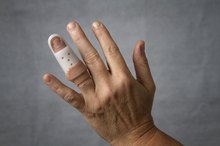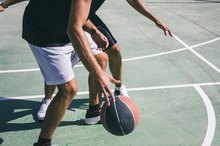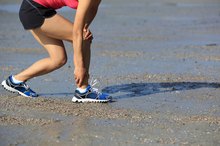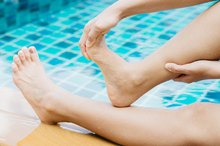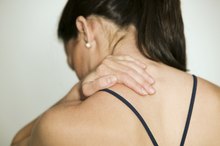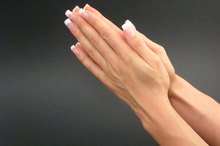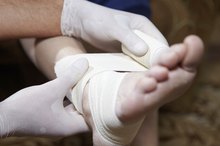Pain in the Hands After Exercise
Certain physical activities can cause muscle soreness in the hands, but pain that lasts after exercising could be a sign of edema, carpal tunnel syndrome or a break. Determining why you are experiencing hand pain after exercising and how to go about treating it are sometimes tricky, so it's important to see your doctor if the pain recurs or doesn't subside.
Muscle Pain
Some hand and finger pain from sports that require dexterity, like golf and weightlifting, is normal and can often be attributed to delayed onset muscles soreness. This type of pain will usually go away on its own shortly. The RICE method (rest, ice, compression, elevation) may help ease pain and reduce swelling, but if the pain lasts more three days or is severe, then visit a doctor. Wearing specialty gloves or grips may help reduce muscle pain while engaging in dexterity-related exercises and sports.
- Some hand and finger pain from sports that require dexterity, like golf and weightlifting, is normal and can often be attributed to delayed onset muscles soreness.
Swelling
Injury to a Forearm Muscle
Learn More
The swelling and tingling in your hands that occurs during and after walking or similar exercises is referred to as edema. Medically, the reason for the swelling is an increase in the volume of fluids in between cells, and it can happen for a variety of reasons. Excessive heat, dehydration and high intake of sodium can lead to edema. Carl "Chip" Lavie, MD, director of the Exercise Laboratories at Ochsner Clinic Foundation, told Fitness Magazine that you can prevent hand swelling by performing arm-exercise movements, such as bicep curls without weights, as you walk.
- The swelling and tingling in your hands that occurs during and after walking or similar exercises is referred to as edema.
- Carl "Chip" Lavie, MD, director of the Exercise Laboratories at Ochsner Clinic Foundation, told Fitness Magazine that you can prevent hand swelling by performing arm-exercise movements, such as bicep curls without weights, as you walk.
Carpal Tunnel Syndrome
Carpal tunnel syndrome is common among people who perform repetitive motions of the hand and wrist, such as playing raquetball or handball, according to the National Institutes of Health. Some of the symptoms of carpal tunnel syndrome include numbness or tingling in the thumb and next two or three fingers of one or both hands, numbness or tingling of the palm of the hand, and weakness in one or both hands. Treatment includes discontinuing the specific sport or exercise, taking medications such as ibuprofen to reduce pain or having surgery. While symptoms often improve with less-invasive treatment, more than 50 percent of cases eventually require surgery, according to the NIH.
- Carpal tunnel syndrome is common among people who perform repetitive motions of the hand and wrist, such as playing raquetball or handball, according to the National Institutes of Health.
Breaks
Recovering From Finger Surgery
Learn More
An additional reason for pain in the hands after exercise that should not be ruled out is a fracture. Fractures can occur either in the small bones of the fingers (phalanges) or the long bones (metacarpals). Signs and symptoms of a broken bone in the hand include swelling, tenderness or the inability to move a particular finger, according to the American Academy of Orthopaedic Surgeons. While many breaks can be realigned by having a doctor manipulating them, sometimes surgery is necessary to restore the hand to full functionality.
- An additional reason for pain in the hands after exercise that should not be ruled out is a fracture.
Related Articles
References
- MedlinePlus: Muscle Aches
- MedlinePlus: Edema
- American Academy of Orthopaedic Surgeons; Hand Fractures; October 2007
- Fitness Magazine: Help -- Workouts Make My Hands Swell
- Genetics Home Reference. Carpal tunnel syndrome. Aug 17, 2020.
- National Institute of Neurological Disorders and Stroke. Carpal tunnel syndrome fact sheet. Updated August 13, 2019.
- Kozak A, Schedlbauer G, Wirth T, et al. Association between work-related biomechanical risk factors and the occurrence of carpal tunnel syndrome: An overview of systematic reviews and a meta-analysis of current research. BMC Musculoskelet Disord. 2015;16:231. doi:10.1186/s12891-015-0685-0
- National Institutes of Health. U.S. National Library of Medicine. Carpal tunnel syndrome. Aug 17, 2020.
- Carpal Tunnel Syndrome. Genetics Home Reference. National Institute of Health: U.S. National Library of Medicine.
- National Institutes of Health: National Institute of Neurological Disorders and Stroke. Carpal Tunnel Syndrome Fact Sheet.
- Cleveland Clinic. Carpal tunnel syndrome: Diagnosis and tests. Updated Oct. 22, 2019.
- Zaralieva A, Georgiev GP, Karabinov V, et al. Physical therapy and rehabilitation approaches in patients with carpal tunnel syndrome. Cureus. 2020;12(3):e7171. Published 2020 Mar 3. doi:10.7759/cureus.7171
- Khosrawi S, Moghtaderi A, Haghighat S. Acupuncture in treatment of carpal tunnel syndrome: A randomized controlled trial study. J Res Med Sci. 2012;17(1):1-7.
- Hains G, Descarreaux M, Lamy AM, Hains F. A randomized controlled (intervention) trial of ischemic compression therapy for chronic carpal tunnel syndrome. J Can Chiropr Assoc. 2010;54(3):155-163.
- Arthritis Foundation. Carpal Tunnel Syndrome.
- Borhan Haghighi A, Khosropanah H, Vahidnia F, et al. Association of dental practice as a risk factor in the development of carpal tunnel syndrome. J Dent (Shiraz). 2013;14(1):37-40.
- Carlson H, Colbert A, Frydl J, et al. Current options for nonsurgical management of carpal tunnel syndrome. Int J of Clin Rheumatol. 2010;5(1):129-142. doi:10.2217/IJR.09.63
- Chammas M, Boretto J, Burmann LM, et al. Carpal tunnel syndrome – part I (Anatomy, physiology, etiology and diagnosis). Revista Brasileira de Ortopedia. 2014;49(5):429-436. doi:10.1016/j.rboe.2014.08.001
Writer Bio
A resident of Edgewood, Ky., Gabrielle Dion has been writing professionally since 1997. In college, she served as editor-in-chief of her campus newspaper, "The Northerner." Dion has worked as a freelance writer for the "Cincinnati Enquirer" and blogged for Cincinnati.com, where she chronicled her first marathon-training experience. She holds a Bachelor of Arts in journalism from Northern Kentucky University.

